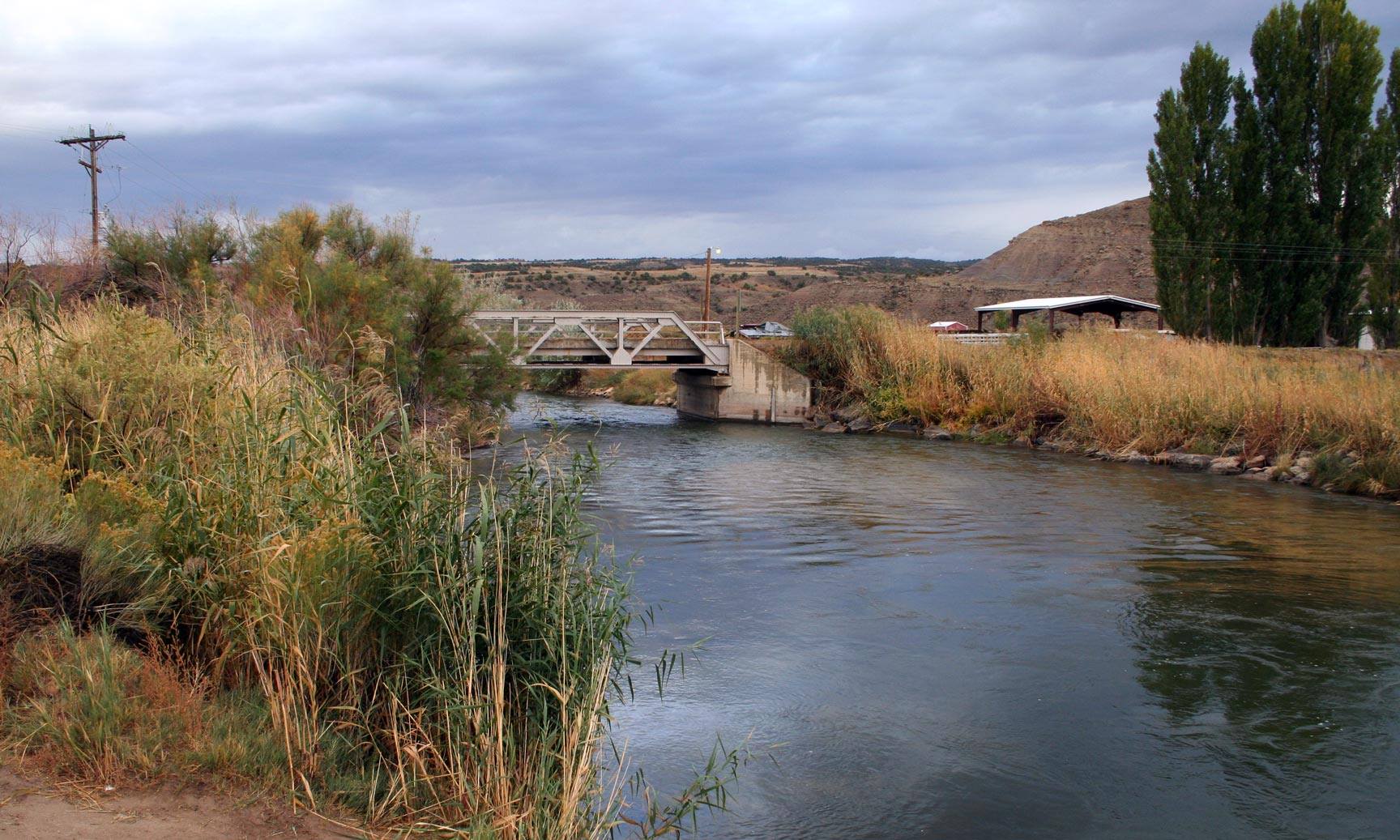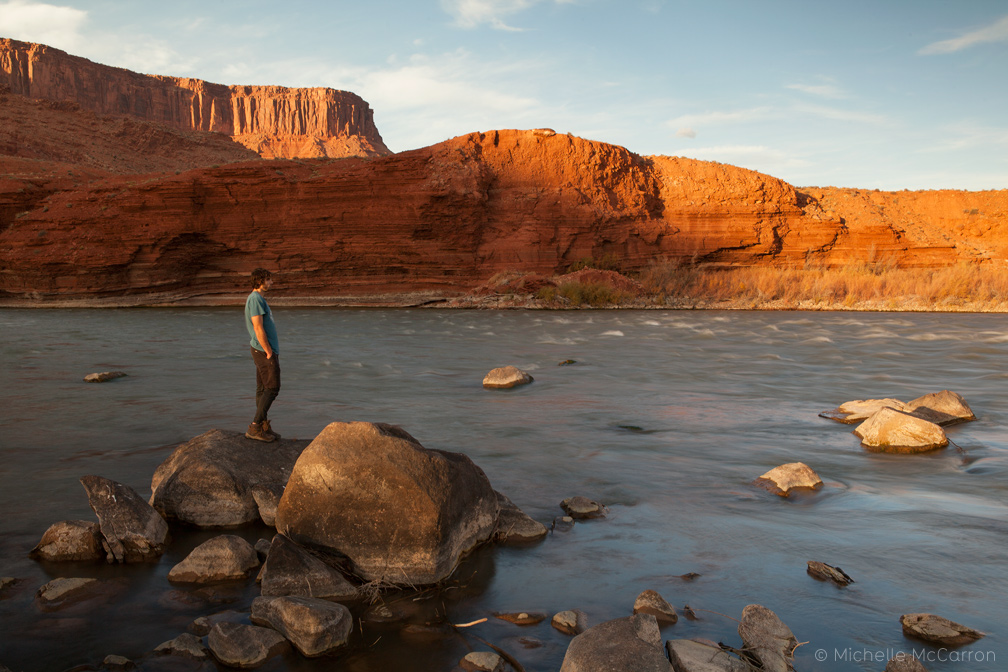
by Deep Green Resistance News Service | Nov 5, 2017 | Listening to the Land
Featured image by Michelle McCarron
Editor’s note: This is the latest installment from Will Falk as he follows the Colorado River from headwaters to delta, before heading to court to argue for the Colorado River to be recognized as having inherent rights. More details on the lawsuit are here. The index of dispatches is here.
by Will Falk / Deep Green Resistance Southwest Coalition
Hear the white crash of her torrents on the boulders she drags through the desert, feel the unyielding red rock she pushes through, lose your balance in the impatience of her swift streams, and you’ll know: The Colorado River needs to provide her waters and yearns for her home in the sea.
I spent several hours in silence with the Colorado River last night listening to her speak of her desires while I pondered our lawsuit that seeks rights for the river. I saw the silver sparks of minnows playing under brown stones. I watched the wind shower gray pools with gold cottonwood leaves. I was washed away in the vertigo caused by the river’s speed conflicting with the primordial stillness of canyon walls. I did not hear a judge’s gavel, evidentiary proceedings, or opposing counsel’s objections. In fact, I neither saw nor heard anything human, save my hands cupped to gather water and the soft beat of blood over my eardrums.
I wondered if the arguments tossed around the small confines of a courtroom or the abstract rights possessing little meaning beyond that granted them by the human mind could give the river what she needs. The river’s needs are physical, concrete, and real. She needs dams to be removed, she needs annual snowfall to return to pre-industrial levels, and she needs poisonous chemicals to be filtered out of her. The question becomes: Can our lawsuit give the river what she needs?
Our lawsuit asks a judge to rule that the Colorado River is a person capable of possessing the rights to exist, flourish, regenerate, and naturally evolve. Personhood gives the person possessing a right the ability to ask a court to enforce the right. A court enforces a right by commanding someone to stop an activity infringing upon a person’s right or by commanding someone to pay the person whose rights were infringed upon. A court ensures a command is followed by calling upon the police (men and women with guns) to compel compliance with a court order.
It is important to understand that filing a lawsuit is nothing more than an attempt to persuade a judge to use force, or the threat of force, to compel someone to act in a certain way. Our Colorado River lawsuit is an attempt to persuade a federal judge to order the State of Colorado to stop activities and projects that violate the river’s rights to exist, flourish, regenerate, and naturally evolve.
If our lawsuit succeeded, and the State of Colorado’s destructive activities were stopped, then, yes, the lawsuit would help to give the Colorado River what she needs. But, the closer our first hearing on November 14 gets, the more anxious I become. My anxiety is rooted in the fact that we do not have control over what happens in the case. Not truly. The lawsuit leaves it up to a judge who spends most of her time behind the walls and under the roof of a courthouse, who most likely lacks the time to sit humbly at the river’s banks to ask her what she needs.
This anxiety is nothing new. It is an anxiety that has become all too familiar to the environmental movement. We continue to lose, the natural world continues to be murdered, because the vast majority of our efforts are spent trying to convince someone else to do the right thing. We can continue to ask someone else to protect those we love, or we can protect them ourselves. More than anything else, the Colorado River needs dams to fall and her waters replenished. The good news is: a court order isn’t the only way a dam falls.
To repost this or other DGR original writings, please contact newsservice@deepgreenresistance.org
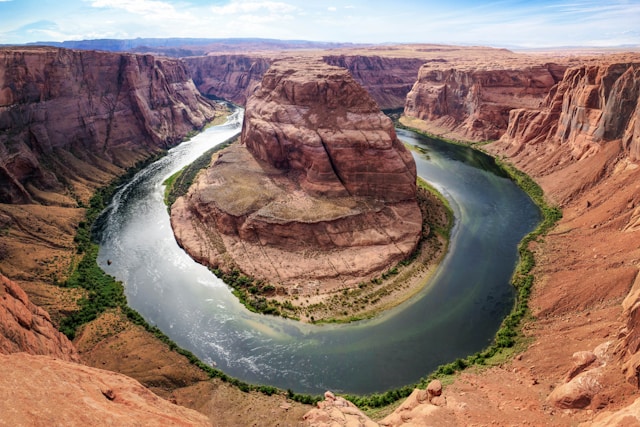
by Deep Green Resistance News Service | Nov 3, 2017 | Lobbying, NEWS
Editor’s note: The Rights of Nature movement has arrived in the United States! On September 25, Deep Green Resistance, with noted civil rights attorney Jason Flores-Williams, filed a first-in-the-nation lawsuit – Colorado River v. Colorado – seeking personhood for the Colorado River and recognition of the river’s rights to exist, flourish, regenerate, and naturally evolve in the United States District Court, District of Denver. While courts in India, New Zealand, and Ecuador have granted rights to ecosytems, this lawsuit represents the first Rights of Nature action ever brought before a federal court. If the case succeeds, the natural world will gain a powerful new tool in the struggle to stop corporate exploitation.
Denver, CO—For the first time in U.S. legal history, a natural entity itself will stand as a party before the court. The first hearing in Colorado River v. Colorado will address emerging legal issues in rights of nature litigation as well as the Attorney General’s Motion to Dismiss.
“You can try to dismiss a complaint,” says attorney Jason Flores-Williams, “But you can’t dismiss reality.”
Prior to the hearing, there will be a press conference at 9:00 a.m. at the federal courthouse featuring statements from members of Deep Green Resistance, serving as “next friends” to the Colorado in this action. Fair trade coffee provided at the courthouse with an event to follow 12 p.m. to 2 p.m. at the Mercury Café located 2199 California St, Denver, CO 80205.
The Mercury Café event will: 1) Provide a guide for groups to file their own rights of nature litigation; 2) Feature a discussion on the rights of nature and creative resistance. The hearing will be at 10:00 a.m. November 14th, 2017 Ctrm C204, Alfred J. Arraj Courthouse, 901 19th St., Denver, CO 80294.
Media inquiries:
Law Office of Jason Flores-Williams
303-514-4524
Editor’s note: you can find the Facebook event here and read the full text of the complaint, Colorado River v. Colorado, here.
Photo by Gert Boers on Unsplash
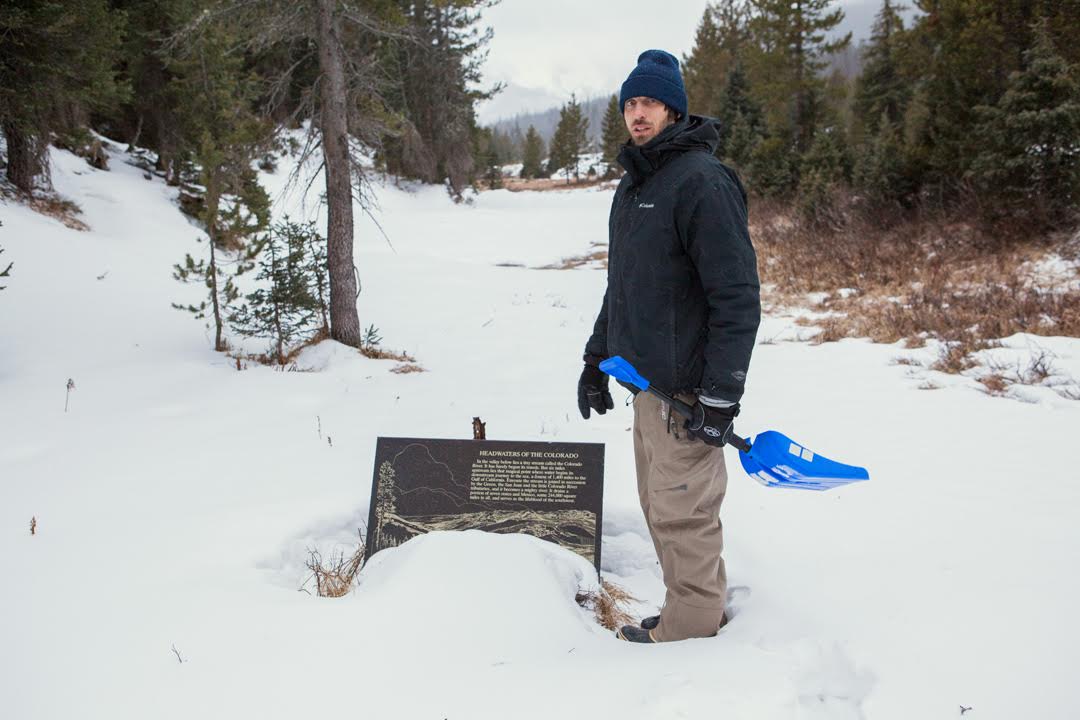
by DGR News Service | Oct 29, 2017 | Listening to the Land
Featured image by Michelle McCarron
Editor’s note: This is the latest installment from Will Falk as he follows the Colorado River from headwaters to delta, before heading to court to argue for the Colorado River to be recognized as having inherent rights. More details on the lawsuit are here. The index of dispatches is here.
by Will Falk / Deep Green Resistance Southwest Coalition
To truly understand someone, you must begin at her birth. So, Michelle and I spent the last two days looking for the Colorado River’s headwaters in the cold and snow above La Poudre Pass on the north edge of Rocky Mountain National Park. The pass is accessible by Long Draw Road off of Colorado Highway 14. Long Draw Road is an unpaved, winding, pot-holed trek that takes you fourteen miles through pine and fir forests and past the frigid Long Draw Reservoir before ending abruptly in a willow’d flat.
We found the road covered in an inch of frosty mud which required slow speeds to avoid sliding into roadside ditches. The drive served as a preparatory period in our journey to the Colorado River’s beginnings. The road’s ruggedness and incessant bumps combined with sub-freezing temperatures to ask us if we were serious about seeing the Colorado River’s headwaters. I was worried that Michelle’s ’91 Toyota Previa might struggle up the pass, but the van continued to live up to the Previa model’s cult status.
Long Draw Road foreshadowed the violence we found at the river’s headwaters. Swathes of clearcut forests escorted the road to the pass. The Forest Service must be too lazy to remove single trees from the road as they fall because Forest Service employees had simply chainsawed every tree within fifty-yards to the left and right of the road. About 3 miles from the road’s end, we ran into a long, low dam trapping mountain run-off into Long Draw Reservoir. We expected to find wilderness in La Poudre Pass, so the dam felt like running into a wall in the dark.
The clearcuts, dam, and reservoir are grievous wounds, but none of them are as bad as the Grand Ditch. We walked a quarter-mile from the end of Long Draw Road where we found a sign marking the location of the river’s headwaters. On our way to the sign, we crossed over a 30-feet deep and 30-feet wide ditch pushing water west to east. We were on the west side of the Continental Divide where water naturally flows west. We contemplated what black magic engineers employed to achieve this feat. The ditch was as conspicuous in La Poudre Pass as a scarred-over gouge on a human face.
The Grand Ditch was begun in the late 1880s and dug by mostly Japanese crews armed with hand tools and black powder. It was built to carry water, diverted from the Colorado River’s headwaters, east to growing cities on Colorado’s Front Range. Close to two feet of swift water ran through the ditch. We learned that even before melting snowpack forms the tiny mountain streams identifiable as the Colorado River’s origins, water is stolen from her. Pausing in a half-foot of powder, I wondered whether the water stored here would end up on a Fort Collins golf course or stirred by the fins of a Vaquita porpoise in the Gulf of California.
Study the Colorado River’s birth and you’ll learn she is born from a wild womb formed by heavy winter clouds, tall mountain peaks, and snowpack. But, she emerges from this womb immediately into exploitation. In La Poudre Pass, the young Colorado River tastes the violence that will follow her the rest of her life.
To repost this or other DGR original writings, please contact newsservice@deepgreenresistance.org
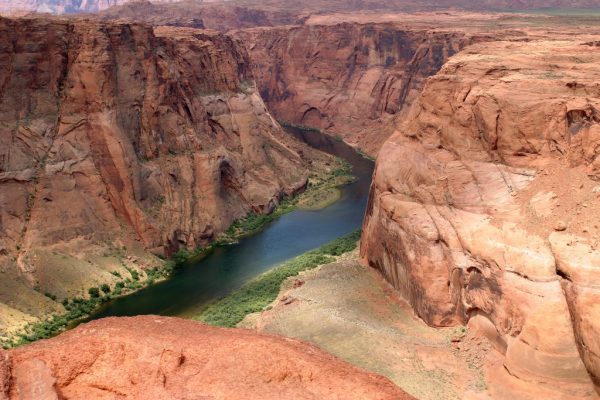
by Deep Green Resistance News Service | Oct 19, 2017 | Strategy & Analysis
Editor’s note: The first Rights of Nature lawsuit in the US was filed on September 25, 2017, in Denver, Colorado. The full text of the complaint can be found here.
by Will Falk / Deep Green Resistance Great Basin
In the war for social and environmental justice, even the best lawyers rarely serve as anything more than battlefield medics.
They do what they can to stop the bleeding for the people, places, and causes suffering on the front lines, but they do not possess the weapons to return fire in any serious way. Lawyers lack effective weapons because American law functions to protect those in power from the rest of us; effective legal weapons are, quite literally, outlawed.
Nonetheless, understanding the limits of the law to affect change through my experiences as a public defender, I recently helped the Colorado River sue the State of Colorado in a first-in-the-nation lawsuit — Colorado River v. Colorado — requesting that the United States District Court in Denver recognize the river’s rights of nature. These rights include the rights to exist, flourish, regenerate, and naturally evolve. To enforce these rights, the Colorado River also requests that the court grant the river “personhood” and standing to sue in American courts.
Four of my comrades in the international environmental organization Deep Green Resistance (DGR) and I, are listed as “next friends” to the Colorado River. The term “as next friends” is a legal concept that means we have signed on to the lawsuit as fiduciaries or guardians of the river. I also serve, with the brilliant Deanna Meyer, as one of DGR’s media contacts concerning the case.
Several times, I’ve been asked whether I think our case is going to win. We have provided, in the complaint we filed, the arguments the judge needs to do the right thing and rule in our favor. In this sense, I think we can win. And, if we do win, the highly endangered Colorado River will gain better protections while the environmental movement will gain a strong new legal weapon to use in defense of the natural world.
But, when has the American legal system been concerned with doing the right thing? While every ounce of my being hopes we win, if we lose, I want you to know why. I want you to be angry. And, I want you to possess an analysis that enables you to direct your anger at the proper targets.
***
The Community Environmental Legal Defense Fund (CELDF) does incredible work to demonstrate how the American legal system is stacked against us. CELDF began as a traditional public interest law firm working to protect the environment. They fought against industrial projects like waste incinerators and dumps only to encounter barriers in the legal system put in place by both government and corporations.
According to CELDF, government and corporations “developed a structure of law which – rather than focused on protecting people, workers, communities, and the environment – was instead focused on endless growth, extraction, and development.” This structure is “inherently unsustainable, and has, in fact, made sustainability illegal.”
The current structure of law forces us into what CELDF calls the “Box of Allowable Activism.” The Box is formed by four legal concepts that have so far proven to be unassailable. Those concepts are state preemption, nature as property, corporate privilege, and the regulatory fallacy. State preemption removes authority from local communities by defining the legal relations between a state and its municipalities as that of a parent to a child. Local communities are not allowed to pass laws or regulations that are stricter than state law.
Currently, nature is defined as property in American law. And, anyone with title to property has the right to consume and destroy it.
As CELDF notes, “this allows the actions of a few to impact the entire ecosystem of a community.” To make this worse, corporations – who own vast tracts of nature – are granted, by American courts, corporate rights and “personhood.” Corporate personhood gives corporations the power to request enforcement of rights to free speech, freedom from search and seizure, due process and lost future profits and equal protection under the law.
Finally, CELDF explains that “the permitting process, and the regulations supposedly enforced by regulatory agencies, are intended to create a sense of protection and objective oversight.” But, while water continues to be polluted, air poisoned, and the collapse of every major ecosystem on the continent intensifying, we must conclude that this protection is not happening.
Regulatory agencies give permits. By definition, they provide permission to destructive activities. CELDF states, “When they issue permits, they give cover to the applicant against liability to the community for the legalized harm.”
***
I went to law school at the University of Wisconsin-Madison and became a public defender in Kenosha, WI because I thought I could push back against the institutional racism of the American criminal justice system. Just like CELDF learned working through traditional environmental law, I learned quickly that my hands were tied by the legal structure, too.
Something similar to CELDF’s “Box of Allowable Activism” exists in criminal law. Prosecutors overcharge. For example, I represented a single mother of three charged with six counts of theft despite the total value of what she was accused of stealing amounting to less than $30 — one count for the bag of rice, one for the butter, one for the salt, one for the pack of chicken breasts, one for the onion, and one for the garlic.
Then, prosecutors offer plea deals taking advantage of a defendant’s rational self-interest and fear. In my previous example, the prosecutor offered to dismiss four of the six counts of theft and recommend 30 days in jail if my client pled guilty to two counts, the rice and chicken. When the prosecutor made her offer, she reminded my client that not taking the deal meant facing a long trial process while risking conviction on all six counts and being exposed to two years in jail.
Defense attorneys are ethically bound to defer to their clients’ desire to take a plea deal. Meanwhile, public defender offices are woefully underfunded. And, with the majority of criminal defendants so poor they qualify for court-appointed counsel, public defenders are notoriously overworked producing mistakes that lead to their clients’ incarceration.

Credit: Wikimedia Commons
Deep ecologist, Neil Evernden, connects the problems facing lawyers fighting institutional racism and lawyers fighting ecocide in his book “The Natural Alien: Humankind and Environment.” Evernden asks us to imagine we are lawyers defending a client who is black in apartheid South Africa or the Jim Crow American south.
He asks, “What would you do if faced with a trial judge who denies your client any rights and who, after hearing your case, simply says: ‘So what — is he white?’”
Everndem claims that we only have two options in this situation. We can demand that the judge recognize the rights and dignity of our client and risk condemning our client to execution. Or, we can play by the rules, reinforce problematic law, contribute to its precedence, and detail our client’s genealogical records at length “to try to prove our client white.”
Evernden correctly notes that too often when environmentalists are challenged to justify their declarations on behalf of the living world, they proceed to try to prove their client white. Evernden writes, “Rather than challenge the astonishing assumption that only utility to industrialized society can justify the existence of anything on the planet” the environmentalist “tries to invent uses for everything.” But, “the only defense that can conceivably succeed in the face of this prejudice is one based on the intrinsic worth of life, of human beings, of living beings, ultimately of Being itself.”
We want our lawsuit, specifically, and the rights of nature framework, generally, to be legal arguments for the intrinsic worth of life and of living beings like the Colorado River.
We are attacking two of the walls forming the Box of Allowable Activism. We seek to overturn the concept that nature is only property, and we seek to erode corporate power by giving the source of corporate power (nature) rights to stop corporate exploitation. These arguments are not currently accepted, but neither was the argument that “separate is inherently unequal” when Thurgood Marshall argued this and ended school segregation in Brown v. Board of Education.
This is all well and good, but we are still forced to construct our argument only with currently acceptable legal language. We seek “personhood” for the Colorado River, for example. But, the river is much more than a person. The river is an ancient and magnificent being who carved the Grand Canyon, who braved some of the world’s most arid deserts on her path from the Rocky Mountains to the Gulf of California, and who facilitates countless lives, human and nonhuman.
I am afraid, that in seeking personhood for the Colorado River, people will mistake our arguments as trying to prove the Colorado River a “person” while reinforcing the notion that a being only has value as far as that being resembles a human.
***
Evernden only contemplated two options. We can prove the Colorado River a person, or we can demand recognition of our client’s dignity. But, there is a third option: Dismantle the power stacking the legal system against communities and natural ecosystems.
To fight this power, we must understand how power works. Dr. Gene Sharp, who CNN has called “a dictator’s worst nightmare” and the “father of nonviolent struggle,” is the world’s leading theorist of power.
Sharp identifies two manifestations of power – social and political. Social power is “the totality of all influences and pressures which can be used and applied to groups of people, either to attempt to control the behavior of others directly or indirectly.” Political power is “the total authority, influence, pressure, and coercion which may be applied to achieve or prevent the implementation of the wishes of the power-holder.”
Sharp lists six sources of power: authority, human resources, skills and knowledge, intangible factors, material resources, and sanctions. Interfering with these sources of power is the key to a successful resistance movement.
The powerful know where their power comes from and they protect the sources of their power. It is one thing to protect these sources with brute force. But, why use brute force when you can persuade the oppressed that there is nothing they can do to affect the sources of power? Or, when you can mislead the oppressed about where those sources of power are?
In this spirit, the powerful do everything they can to convince the oppressed that the current arrangement of power is inevitable. They seek to convince us that the legal system exists to protect communities and the environment. They teach us to look back through history to view our few victories as the result of a system devoted to justice.
These few victories are held up as proof that sooner or later the courts always make the right decision. We are pacified with assurances that if our lawyers are clever enough, if they work hard enough, if they articulate the truth eloquently enough, judges will recognize the brilliance of our lawyers’ arguments and justice will be served.
Justice for the natural world has rarely been served. CELDF names the final blockade to justice the “Black Hole of Doubt” and teaches, “We think we’re not smart enough, strong enough, or empowered enough – we literally do not believe we have the inalienable right to govern.” Sharp says, “Power, in reality, is fragile, always dependent for its strength and existence upon a replenishment of its sources by the cooperation of a multitude of institutions and people – cooperation which may or may not continue.”
Any resistance movement aspiring to true success must engage in shrewd target selection to undermine sources of power. Taking Sharp a step further, it is possible to prioritize which sources are more essential to the functioning of power than others. Corporate power is maintained through the exploitation of the natural world. There is no profit without material products. There are no material products without the natural world. If corporations lose access to ecosystems like the Colorado River, they will fail. If corporations fail, they can no longer control our system of law.
We may win in court and corporations will have to respect the Colorado River’s rights to exist, flourish, regenerate, and naturally evolve. We will also gain a foothold for other ecosystems to assert their own rights. We may fail in court, but that does not mean the fight is over.
In many ways, our failure would simply confirm what we already know: the legal system protects corporations from the outage of injured citizens and ensures environmental destruction. If we fail, we must remember there are other means — outside the legal system — to stop exploitation.
Regardless of what happens in our case, we encourage others to employ whatever means they possess to protect the natural world who gives us life.
To repost this or other DGR original writings, please contact newsservice@deepgreenresistance.org




